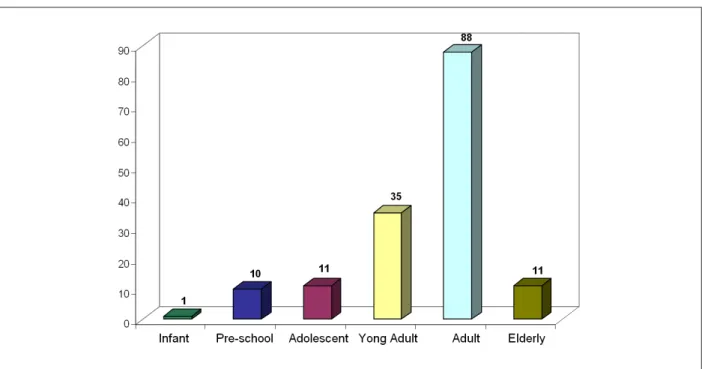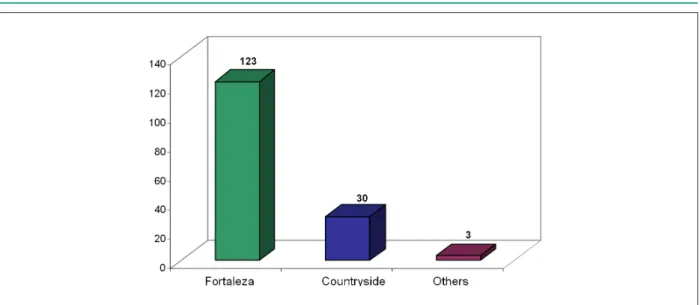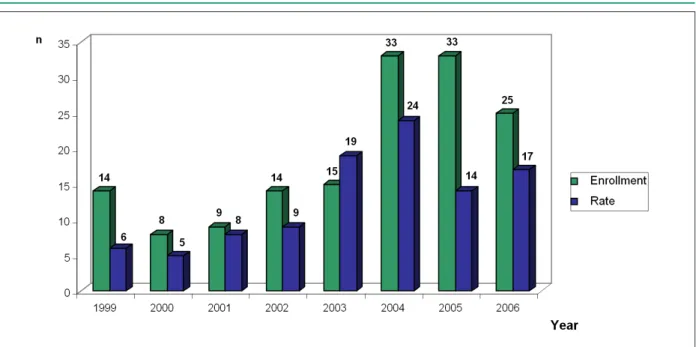Francisca Elisângela Teixeira Lima
1, Adriana Kelly Almeida Ferreira
3, Kelly de Araújo Fontenele
3, Eliana Régia
Barbosa de Almeida
2Universidade Federal do Ceará1; Central de Transplante do Ceará2; Universidade de Fortaleza3, Fortaleza, CE - Brazil
Mailing address: Francisca Elisângela Teixeira Lima •
Av. dos Expedicionários, 3406, bl.1 apt. 1203 - Benfica - 60410-410 - For-taleza, CE - Brazil
E-mail: felisangela@yahoo.com.br
Manuscript received April 14, 2009; revised manuscript received September 16, 2009; acepted January 27, 2010.
Abstract
Background: Organ transplants have increased considerably in recent years because of technological developments and society’s awareness for organ donation.
Objective: To describe the characteristics of the single list of patients waiting for heart transplantation; to identify the main heart diseases; and determine the average time a patient stays in the list until the surgery.
Methods: This is a descriptive, documentary and retrospective study with a quantitative approach. It was developed at the Transplant Center of the State of Ceará, with 156 patients included in Unified Waiting List from 1999 to 2006. Data were organized into figures.
Results: There were: 81% males; 22.4% of young adults (20 to 40 years old) and 56.4% middle-aged adults (40 to 64 years old), averaging 36 years old; 79% from Fortaleza-CE; 91% with cardiomyopathy as a cause of heart transplantation. Among these, 102 patients (69%) were transplanted; 37 (25%) died before transplantation; and 8 (6%) were excluded due to improvement or worsening of clinical status.
Conclusion: The patients from the Unified Waiting List for Heart Transplantation in the state of Ceará, from 1999 to 2006, were male (80%), with ages ranging from 1 to 71 years, with a predominance of dilated cardiomyopathy (53.4%), and the average waiting time was 136 days until the day of cardiac transplantation. (Arq Bras Cardiol. 2010; [online]. ahead print, PP.0-0)
Key words: Health profile; heart transplantation; waiting lists; Fortaleza (CE); Brazil.
There is a difficulty in obtaining organs and tissues, as well as in setting up the necessary structure to perform procedures. We found, for second year in a row, a decreased rate of effective donors in Brazil. In 2004, the rate was 7.3 donors per million people (pmp), to 6.4 pmp in the following year and 6.0 in 2006. One of the largest reductions was found in heart, pancreas and kidney transplantations3.
Cardiovascular diseases stand out among chronic impairments because they account for 16.7 million deaths annually, with forecasts for 2020 for its maintenance as a major cause of mortality and disability4. Ceará is the second state in
Brazil in terms of number of transplants and the fifth in heart transplantation at the Hospital of Messejana5.
Given these data, this study aims at: describing the characteristics of the patients enrolled in the Unified Waiting List for heart transplants, considering gender and age; determining the main heart diseases leading to heart transplantation and checking patients’ average length of stay in Unified Waiting Lists until surgery.
Methods
This is a descriptive, documentary and retrospective study with quantitative analysis. The documents reviewed were the medical records of 156 patients enrolled in the Unified Waiting
Introduction
Brazil has the largest public system of transplantation of organs and tissues, and is ranked second in the performance of this procedure, behind the United States. According to the Federal Audit Court, in May 2005, 62,785 patients were waiting for a transplant1.
List for heart transplant from 1999 to 2006, either transplanted or not, regardless of gender and age.
Data collection occurred in September and October 2007 from the Brazilian Transplant Database available at the Transplant Center of Ceará, located in the city of Fortaleza. We used a form containing age, sex, date of inclusion and exclusion from the Unified Waiting List for cardiac transplantation, underlying disease, death cases, and other relevant data, in order to achieve the goals intended.
The data were organized and tabulated in tables and displayed in figures in the Excel program of Windows XP Professional. The findings were based on the literature relevant to the topic.
The ethical and legal aspects were covered, since the study was conducted according to Resolution 196/96 of the Brazilian Health Comission6. The project was evaluated by the Ethics
and Research Committee of the University of Fortaleza, and approved under no. 214/07.
Results
General characteristics of patients enrolled in the Uniied Waiting List for heart transplantation
As for gender, as shown in Figure 1, we found that 125 (81%) individuals were male and 31 (19%) were female. Figure 2 shows that the age ranged from 1 to 71, of which 56.4% were predominantly middle-aged adults (40 to 64 years) and 22.4% young adults (20 to 40 years old), with an average of 36 years. Figure 3 shows the prevalence of patients from the capital of Ceará, representing 79% of the sample, 19% were from the countryside of the state and 2% were from other Brazilian states. Two individuals came from Rio Grande do Norte and one from Rio Grande do Sul.
Factors related to cardiac transplantation and Uniied Waiting List
It can be seen in figure 4 that the main causes leading to heart transplantation in Ceará are the following cardiomyopathies: dilated (70), ischemia (22), Chagas’ disease (19), idiopathic (18), alcohol (14) and hypertrophic (1). In addition to other diseases (12), including valvular, congenital cardiac malformation and heart failure.
Figure 5 shows a considerable increase in the number of patients enrolled in the waiting list for transplantation, with a more evident growth in 2004 and 2005, despite a slight reduction in 2006. The average length of stay in the Unified Waiting List was 136 days. Many patients waited this time and could be transplanted, however this average includes patients who were excluded from the list for some other reason.
Figure 1 -Characteristics of patients enrolled in the Uniied Waiting List for heart transplantation, according to sex. Ceará, 1999-2006.
Figure 3 -Characteristics of patients enrolled in the Uniied Waiting List for heart transplants, according to the origin. Ceará, 1999-2006.
Figure 4 -Characteristics of patients enrolled in the Uniied Waiting List for heart transplantation according to diagnosis related to cardiac transplant. Ceará, 1999-2006.
As for heart transplants, there was an increase until 2004, when 24 transplants were performed. The year of 2005 saw a decline in the number of procedures performed with 14 transplantations. In 2006, this increased to 17.
It was found that the 156 patients enrolled in the Unified Waiting List, 102 (65.4%) were transplanted; 37 (23.7%) died before transplantation; and 8 (5.1%) from those who entered the list were excluded due to improvement or worsening of symptoms and 9 (5.8%) remain in the list.
Discussion
The analysis of age was performed from the development stages classified according to the literature7: lactation (from
birth to 1 year), early childhood (1 to 3 years), preschool (3 to 6 years), school (7 to 10 years), preadolescent (10 to 12 years),
adolescent (12 to 19 years), young adults (20 to 40 years), middle-aged adults (40 to 64 years) and elderly (≥ 65 years).
Age data are consistent with the literature, which states that the predominant age group in the Unified Waiting List for cardiac transplantation is between 35 and 60 years old8. The age limit for heart transplantation is relative and
hardly decided. Biological factors have greater influence than chronological age itself. Heart transplantation can be performed in patients with ages ranging from newborns to the elderly, as it was found in the population enrolled9.
Figure 5 -Characteristics of patients according to year of enrollment in the Uniied Waiting List and year of heart transplantation. Ceará, 1999-2006.
valvular cardiomyopathy in 2.1% and other cardiomyopathies in 2.1% of patients10. In another study, conducted in another
period, idiopathic dilated cardiomyopathy (37.5%), ischemic cardiomyopathy (33.9%), Chagas’ disease (17.5%) also prevailed7. Another more recent study found similar findings,
with prevalence of idiopathic dilated cardiomyopathy (39%), Chagas’ disease (26.5%), ischemic cardiomyopathy (24.2%) and other etiologies (10.3%)11.
Dilated cardiomyopathy is characterized by a uni or biventricular dysfunction with a progressive character, with deficiency in contractility; the etiology is varied and may be caused by multiple factors, including genetic, immunological and infectious factors which are decisive for myocardial injury12.
Therefore, health professionals should develop educational strategies in order to decrease the rate of cardiovascular diseases, and consequently reduce the need for heart transplantation.
By comparing the enrollment in the Unified Waiting List with the performance of transplantation, it appears that, except in 2003, all years from 1999 until 2006 saw a greater number of people enrolled in the list and eventually transplanted. This finding is consistent with the study performed at the Heart Institute, in São Paulo, with 141 clients with priority for heart transplantation, in which it was found that 10% to 40% of patients selected for transplantation cannot wait for the donation and die in while waiting11.
Data provided by the Transplant Center of the State of Ceará state that the years of 2004, 2005 and 2006 were marked by the increasing number of patients who made up the waiting list with 928, 1,065 and 1,241, respectively.
This finding reveals the need to promote educational campaigns aimed at encouraging people to authorize the donation of their and their relatives’ organs in case of brain death. The literature13 emphasizes that families should be
informed, even at times of mourning, that the organs of their
loved ones could save the lives of others, or at least improve their quality of life.
Over 1999 to 2006, 31% of patients enrolled in the Unified Waiting List for heart transplantation were excluded from the list; among which 25% died and 6% were withdrawn. Such percentage is higher than that found in the studies of the United Network for Organ Sharing (UNOS), which show that 28% of patients eligible for transplantation die or are withdrawn from the waiting list9.
Many are the attempts to solve the shortage of organs, including the production of transgenic animals and the use of mechanical circulatory assistance devices, which enables patients with circulatory system failure to wait longer for a transplant8.
It may be noted that, despite advances in the development of techniques for carrying out this procedure and development of drugs that contributed to increased survival, as well as legal transplants and increased number of laws that regulate this practice, there are still many barriers to be overcome. The main one is lack of donors, a world problem. The shortage of donors only extends the suffering of these people who need a transplant, especially those patients who are on the priority list for being hospitalized in critical conditions, whose inability is evident14.
Besides the problem of shortage of donors, the correct approach is rarely adopted by health professionals towards the relatives of a potential donor, because it is a delicate and decisive stage. These relatives must be approached so that they can understand what the diagnosis of brain death mean. Besides this, their questions, their feelings and insecurities should be clarified. Such monitoring approach will help relatives in making the decision, making the patient a potential donor15.
is a problem that interferes with the transplants. However, many professionals are not aware of the need to maintain potential donors. There may be even failures in the diagnosis of brain death, late notices to the Transplant Center, and the few campaigns on organ donation are also some of the barriers to be overcome8.
Conclusions
The development of this study enabled characterizing 156 patients enrolled in the Unified Waiting List for Heart Transplantation from 1999 to 2006. The conclusions were: 80% of patients were male, with ages ranging from 1 to 71 years old, averaging 36 years. The prevailing heart disease that patients from Ceará to heart transplantation was dilated cardiomyopathy (53.4%). The average time a patient stays in the Unified Waiting List until the surgery was 136 days. We found an increase in the number of patients enrolled in the waiting list for transplantation until the year 2004.
By comparing the enrollment in the Unified Waiting List with the completion of transplantation, it appears that, except in 2003, all years from 1999 to 2006 saw a greater number of people enrolled in the list, compared to those who are transplanted.
Implications for the practice
We observed the importance of health care for patients enrolled in the Unified Waiting List, since the length of stay vaies from one day to years. For this purpose, it becomes paramount to train of in-hospital organ transplant commissions
in order to qualify these professionals to take care of patients and their relatives in a holistic and individualized way.
Health professionals working in the Brazilian Transplant Database are increasingly responsible for explaining the procedures performed, and informing the number of people enrolled in the Unified Waiting List, the deaths that occur while in the list, and the difference between the number of brain deaths reported and the donations authorized. Such disclosure may sensitize and instruct people about the stages of heart transplantation, demystifying it.
We suggest campaigns to encourage organ donation in order to increase the number of donations; development of mechanisms to assess the quality of services, disseminating the results; monitoring of the survival of patients who underwent heart transplantation in the State of Ceará, and encouragement to the development of studies on this subject.
Potential Conflict of Interest
No potential conflict of interest relevant to this article was reported.
Sources of Funding
There were no external funding sources for this study.
Study Association
This study is not associated with any post-graduation program.
References
1. Saúde nega problemas em fila de transplantes. Folha de São Paulo, São Paulo. 2006 abr 25. [Acessado em 2009 abr 13]. Disponível em: http://www.fbh. com.br/index.php?a=principal_temp.php&ID_MATERIA=4251. 2. Marinho A. Estudo sobre as filas para transplante no Sistema Único de Saúde
brasileiro. Cad. Saúde Pública. 2006; 22 (10): 2229-39.
3. Bruno M. Aumentam as doações de órgãos no Ceará. Diário do Nordeste: Ceará. [Acessado em 2009 abr 11]. Disponível em: http://www.adote.org. br/noticias/htm.
4. Avezum A, Guimarães HP, Piegas LS. Fatores de risco associados com infarto agudo do miocárdio na região metropolitana de São Paulo e no Brasil. In: Nobre F, Serrano Jr CV. Tratado de Cardiologia SOCESP. Barueri (SP): Manole; 2005. p. 22-33.
5. 100º transplante cardíaco no Ceará. O Povo. Ceará. 2009 abr 11. [Acessado em 2009 abr 11]. Disponível em: http://www.saude.ce.gov.br/clipping/ modules.php?name=News&file=article&sid=6260.
6. Ministério da Saúde. Conselho Nacional de Saúde. Resolução Nº. 196/96. Decreto Nº. 93.933 de janeiro de 1987: estabelece critérios sobre pesquisa envolvendo seres humanos. Bioética. 1996; 4 (2): 15-25.
7. Jarvis C. Exame físico e avaliação em saúde. 3ª. ed. Rio de Janeiro: Guanabara Koogan; 2002.
8. Assef MAS, Valbuena PFMF, Neves Jr MT, Correia EB, Vasconcelos M,
Magalhães HM, et al. Transplante cardíaco no Instituto Dante Pazzanese de Cardiologia: análise da sobrevida. Rev Bras Cir Cardiovasc. 2001; 16 (4): 289-304.
9. Garcia VD. Transplante de órgãos e tecidos. 2ª. ed. São Paulo: Segmento Farma; 2006.
10. Couto WJ, Branco JNR, Almeida D, Carvalho AC, Vick R, Teles CA, et al. Transplante cardíaco e infecção. Rev Bras Cir Cardiovasc. 2001; 16 (2): 141-51. 11. Moreira LFP, Galantier J, Benício A, Leirner AA, Fiorelli AI, Stolf NAG, et al.
Perspectivas da evolução clínica de pacientes com cardiomiopatia chagásica listados em prioridade para o transplante cardíaco. Rev Bras Cir Cardiovasc. 2005; 20 (3): 261-9.
12. Mattos BP. Mecanismos patogênicos, função ventricular e biópsia endomiocárdica na miocardiopatia dilatada. Rev HCPA. 2005; 25 (3): 60-4. 13. Quase 70 mil brasileiros aguardam doação de órgãos para transplante. O
Globo. Rio de Janeiro 2006 set 25. [Acessado em 2009 mar 9]. Disponível em: http://www.adote.org.br
14. Vita WLS, Boemer T, Boemer MR. A questão dos transplantes e suas interfaces. O Mundo da Saúde. 2002; 26 (1): 158-66.


